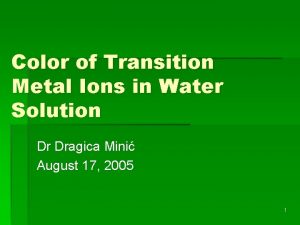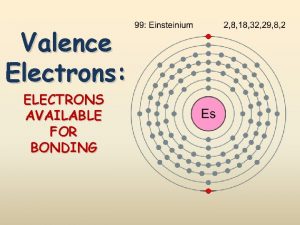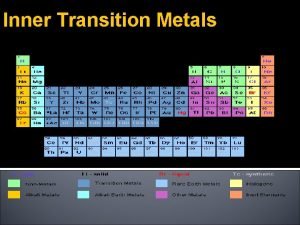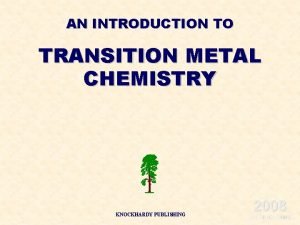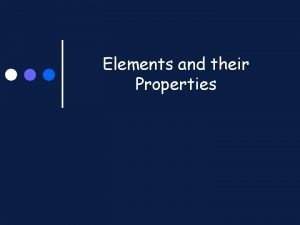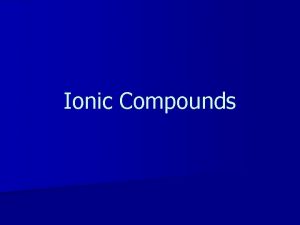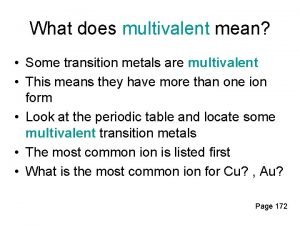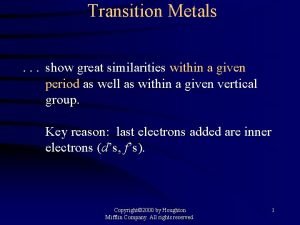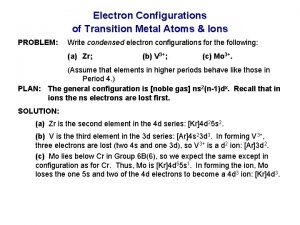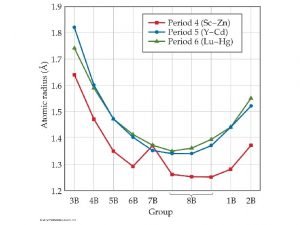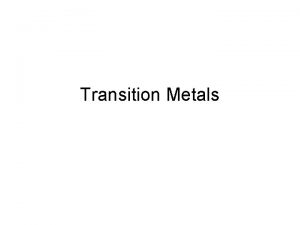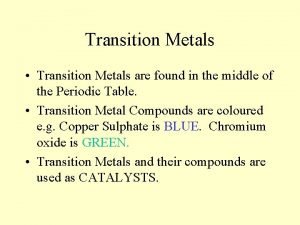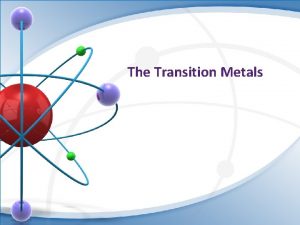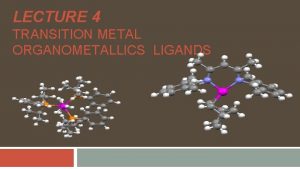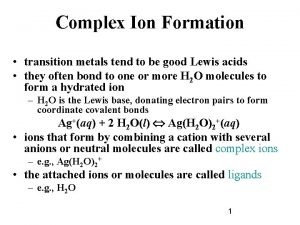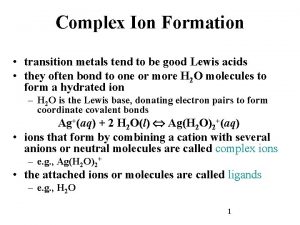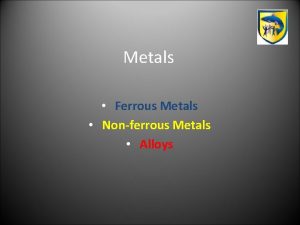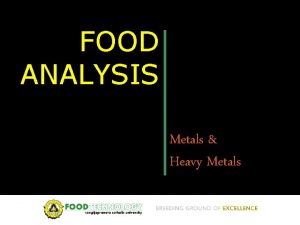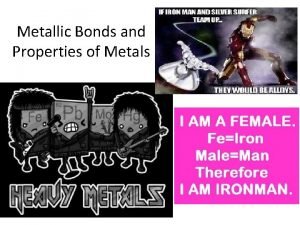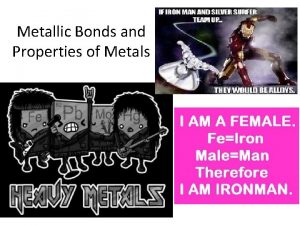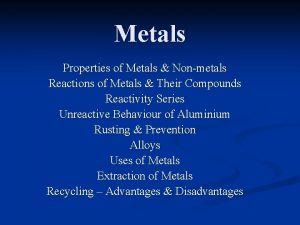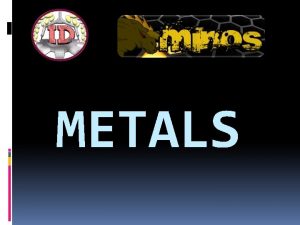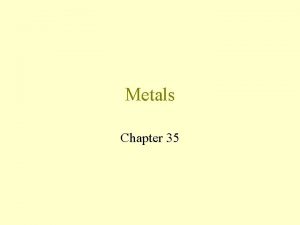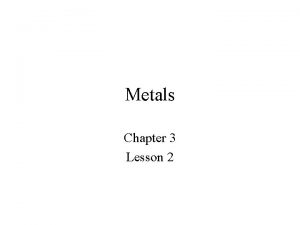Transition Metals Definitions Complex A metal ion surrounded





















- Slides: 21

Transition Metals

Definitions • Complex: A metal ion surrounded by ligands. • Ligand: an electron pair donor i. e. a molecule or ion joined onto the metal ion by a dative covalent bond to the metal. • Coordination number: The number of atoms directly joined to a transition metal by a coordinate (dative covalent) bond.

Typical ligands • Unidentate H 2 O: : NH 3 : Cl • Bidentate C 2 O 42 - H 2 NCH 2 NH 2 • Multidentate EDTA 4 • Watch out for the chelate effect.

Shapes • Six-coordinate complexes are octahedral. eg Cu(H 2 O)62+ Co(NH 3)63+ • Four-coordinate complexes are usually tetrahedral eg Co. Cl 42 - but a few are square planar eg Ni(CN)42 -. • Two-coordinate complexes are linear eg Ag. Cl 2 -.

Colour • Most transition metal colours are due to d-d electron transitions. The energy gap between the split d-orbitals corresponds to visible light (E=hf). • Some of the really strong colours are due to charge transfer (such as in Mn. O 4 -).

Changing colour • Anything that changes the energy difference between the d-orbitals causes a change in colour: • Oxidation state • Ligand • Coordination number

Measuring concentration by colour A measurement of colour intensity (using a colorimeter) can measure the concentration of a solution. Sometimes a special complex is formed so that the colour is more intense. This is known as UV/visible spectroscopy. eg Fe(H 2 O)63+ + SCN- Fe(H 2 O)5(SCN)2+ + H 2 O

Reaction types • The reactions of the transition metals come under three headings (but sometimes more than one occurs at the same time!). • Ligand substitution • Hydrolysis (the acidity reaction) • Redox

Ligand substitution • One kind of ligand is replaced by another. For example, Cu(H 2 O)62+ + 4 Cl- → Cu. Cl 42 - + 6 H 2 O

Hydrolysis (the Acidity reaction) • One or more hydrogen ions is removed. For example, Cu(H 2 O)62+(aq) + 2 OH-(aq) → Cu(H 2 O)4(OH)2(s) + 2 H 2 O(l)

Redox The oxidation state of the metal is changed by adding or removing one or more electrons For example, Co(NH 3)62+ → Co(NH 3)63+ + e-

Titanium • Mainly known for its chloride, Ti. Cl 4, as part of the Kroll process for extraction of titanium from its ores. • The chloride is covalently bonded. • Titanium oxide, Ti. O 2 , is used as a white pigment.

Vanadium • Most stable form is V(IV) eg as VO 2+. • V(V) can be reduced in acidic conditions (eg Zn / HCl) VO 2+ → V(H 2 O)63+ → V(H 2 O)62+ is unstable in air since it is oxidised by oxygen.

Chromium • Cr(H 2 O)63+ Cr(H 2 O)3(OH)3 Cr(OH)63 - >>>>Increasingly alkaline conditions>> Cr 2 O 72 - Cr. O 42<<<<Increasingly alkaline conditions<<<<

Manganese • Mn(H 2 O)62+ II v. pale pink Mn. O 2 Mn. O 42 - Mn. O 4 IV VI VII brown deep purple Mn. O 4 - is a very strong oxidising agent. Use acidic conditions. For titrations, make sure you add sufficient sulfuric acid to take Mn all the way to Mn 2+. Otherwise you get incomplete reduction (the brown solid, Mn. O 2 is formed, rather than Mn 2+).

Iron • Fe(H 2 O)62+ is non-acidic in water (green). • Pure Fe(H 2 O)63+ is a lilac colour but on contact with water goes rusty brown. • Fe(H 2 O)62+ forms Fe(OH)2 (a green solid) with Na. OH but it goes brown (forming Fe(OH)3 on standing in air.

Cobalt add ammonia solution add hydrogen peroxide (or air) Co(H 2 O)62+ → Co(NH 3)63+ pink Add conc HCl brown / yellow Add Na. OH or NH 3 (aq) Co. Cl 42 blue Co(OH)2 blue-grey orange

Nickel add ammonia solution Ni(H 2 O)62+ Ni(NH 3)62+ green Add conc HCl blue Add Na. OH or NH 3 (aq) Ni. Cl 42 - Ni(OH)2 blue pale green Add Na. CN (aq) Ni(CN)42 a square planar complex!

Copper add ammonia solution Cu(H 2 O)62+ Co(NH 3)4(H 2 O)22+ blue Add conc HCl deep blue / violet Add Na. OH or NH 3 (aq) Cu. Cl 42 - Cu(OH)2 yellow-green pale blue

Silver Small quantity of Na. OH, NH 3(aq) Ag+(aq) Cl- Ag. Cl(s) excess Cl- Ag. Cl 2 - excess NH 3 (aq) Ag 2 O(s) Ag(NH 3)2+ Na. CN(aq) Na 2 S 2 O 3(aq) Ag(S 2 O 3)23 - Ag(CN)2 -

Uses of transition metals and their complexes • V 2 O 5 is used as a catalyst in the Contact Process (manufacture of sulfuric acid). • Cis-platin (a platinum complex) is a very effective anti-cancer drug. • Fe 2+ is an important part of haemoglobin. • Ag(NH 3)2+ is Tollen’s reagent (test for aldehydes). • Ag(S 2 O 3)23 - is formed during photographic processing. • Ag(CN)2 - is used in electroplating.
 Transition metal ion colours
Transition metal ion colours Transition metal ion colours
Transition metal ion colours Periodic table with metals and nonmetals
Periodic table with metals and nonmetals Matter and materials (grade 7 worksheets)
Matter and materials (grade 7 worksheets) Ferrous vs non ferrous
Ferrous vs non ferrous Reactivity periodic trend
Reactivity periodic trend Characteristics of metals
Characteristics of metals Grade 7 term 2 natural science
Grade 7 term 2 natural science Fuerzas de london
Fuerzas de london Induced dipole induced dipole attraction
Induced dipole induced dipole attraction Ejemplo de fuerza ion ion
Ejemplo de fuerza ion ion Dipolo dipolo inducido
Dipolo dipolo inducido Ionic compounds containing transition metals
Ionic compounds containing transition metals Group with 6 valence electrons
Group with 6 valence electrons Inner transition metals definition
Inner transition metals definition Knockhardy chemistry
Knockhardy chemistry Elements and their properties
Elements and their properties What's a chemical bond
What's a chemical bond Multivalent metal example
Multivalent metal example Transition metals display great similarities
Transition metals display great similarities Transition metal electron configuration
Transition metal electron configuration Spectrochemical series
Spectrochemical series

